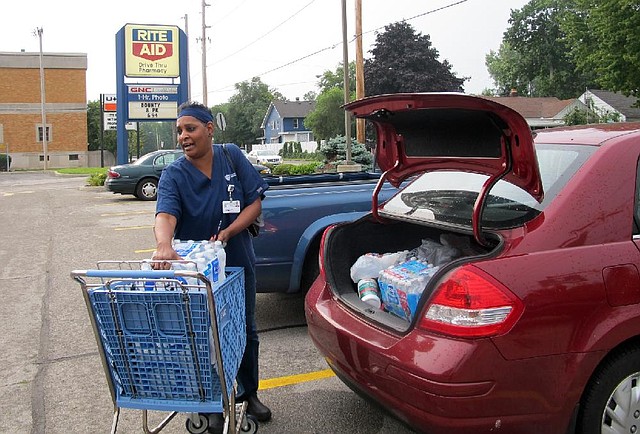Toxins foul Ohio city's water
Officials warn 400,000 residents of Toledo not to drink it
Sharon Green loads bottled water into her car she bought after Toledo warned residents not to use its water, Saturday, Aug. 2, 2014 in Toledo, Ohio. About 400,000 people in and around Ohio's fourth-largest city were warned not to drink or use its water after tests revealed the presence of a toxin possibly from algae on Lake Erie. (AP Photo John Seewer)
Sunday, August 3, 2014
TOLEDO, Ohio -- Toxins possibly from algae on Lake Erie fouled the water supply of Ohio's fourth-largest city, forcing officials to issue warnings Saturday not to drink the water as residents descended on stores, clearing shelves of bottled water.
"It looked like Black Friday," said Aundrea Simmons, who stood in a line of about 50 people at a pharmacy before buying four cases of water. "I have children and elderly parents. They take their medication with water."
The city advised about 400,000 residents in Toledo, most of its suburbs and a few areas in southeastern Michigan not to brush their teeth with or boil the water, which would increase the toxin's concentration.
State emergency operations spokesman Chris Abbruzzese warned residents to use the water only to shower or wash their faces. He advised that residents not bathe their children because they may accidentally ingest the water.
According to an alert issued by the city, chemists were conducting tests at Toledo's Collins Water Treatment Plant when the samples tested positive for microcystin. Symptoms of microcystin ingestion include diarrhea, nausea, dizziness and abnormal liver function, according to the alert.
In severe cases, seizures and respiratory arrest may occur, according to a 2012 report from the Environmental Protection Agency, but fatalities are rare.
Algae blooms during the summer have become more frequent and troublesome on the western end of Lake Erie, the shallowest of the five Great Lakes.
The algae growth is fed by phosphorus mainly from farm fertilizer runoff and sewage treatment plants, leaving behind toxins that have contributed to oxygen-deprived dead zones where fish can't survive. The toxins can kill animals and sicken humans.
Scientists had predicted a significant bloom of the blue-green algae this year, but they didn't expect it to peak until early September.
Gov. John Kasich's emergency order issued Saturday allowed the state to begin trucking water into the Toledo area. Large containers were being filled with water at a prison near Columbus and trucked about 130 miles north to Toledo, said Joe Andrews, a spokesman for the Ohio Department of Public Safety.
The state also asked major grocery store chains to divert as much water as they can to northwest Ohio, Andrews said.
As truckloads of water came in from across the state, Toledo leaders set up distribution centers at schools across the city, limiting families each to one case of bottled water. Some stores were receiving new shipments of water and putting limits on how much people can buy.
"We're going to be prepared to make sure people are not without water," Toledo Mayor Michael Collins said.
He said the city hopes to know by Saturday night how long the warning will stay in place, and he pleaded with residents not to panic. There were no reports of people becoming sick from drinking the water, Collins said.
Samples of the water were flown to the federal and state EPA offices in Cincinnati and Columbus and a university in Michigan for additional testing.
Police officers were called to stores as residents lined up to buy bottled water, bags of ice and flavored water.
"People were hoarding it. It's ridiculous," said Monica Morales, who bought several cases of bottled water before the store sold out a half-hour after opening.
Stores in cities up to 50 miles away were reporting shortages of bottled water. Some neighboring communities that aren't connected to Toledo's water system were offering their water to people who brought their own bottles and containers.
Operators of water plants all along Lake Erie, which supplies drinking water for 11 million people, have been concerned over the past few years about toxins fouling their supplies.
Almost a year ago, one township just east of Toledo told its 2,000 residents not to drink or use the water from their taps. That is believed to be the first time a city has banned residents from using the water because of toxins from algae in the lake.
Most water treatment plants along the western Lake Erie shoreline treat their water to combat the algae. Toledo spent about $4 million last year on chemicals to treat its water and combat the toxins.
Information for this article was contributed by John Seewer of The Associated Press and by James Queally of the Los Angeles Times.
A Section on 08/03/2014
26480867
